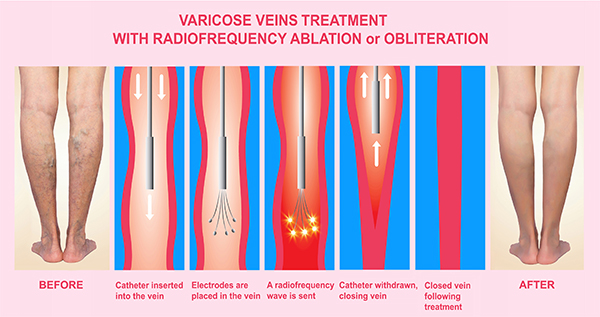Radiofrequency Ablation

What is Radiofrequency ablation (VNUS closure)?
This modern technique is a minimally invasive treatment option for varicose veins. The varicose veins are treated by the principle of heat induced damage to the inner lining of the veins by using radiofrequency energy. A special narrow tube (catheter) is attached to a radiofrequency generator which is used to obliterate (close) the faulty vein using locally directed heat. The blood is then redirected through nearby healthy veins.
The procedure is often performed under general anaesthetic. An ultrasound scan will be used to mark the veins that require treatment. A small flexible wire will be passed into the vein and a narrow tube (sheath) is passed over this wire and then the radiofrequency or laser probe is threaded through the tube. The position of the probe will be checked and further local anaesthetic will be injected around the vein. The generator then creates heat energy to seal the vein from the inside. This takes just a few minutes. Once the vein has been sealed the probe is removed.
What advantage does endovenous treatment have over conventional surgery?
- Normal activity can be resumed straight away and you should be able to return to work within a few days after the procedure
- Removes the need for a groin incision, leaves fewer scars and less potential for complications such as wound infection and pain following surgery.
- Shown to cause much less pain and bruising than conventional surgery.
What are the potential complications of endovenous treatment?
- Some patients have bruising and tenderness that lasts longer than a week. This bruising is more common if you have had varicose veins removed through surgical incisions at the same time as the endovenous treatment.
- It is not uncommon for some discomfort to develop around the obliterated vein between 5 and 10 days after the procedure due to inflammation. If this occurs you may require anti-inflammatory tablets such as ibuprofen (unless there are contraindications).
- Some patients experience numbness in the leg after endovenous treatment and this is usually temporary, although it can be permanent.
- There is a small risk of skin burns from the catheter.
- As with any surgical procedure there is a small risk (1:1000) of blood clots forming in the deep leg veins (DVT), although this is less common than with conventional surgery.
What is “Venaseal” glue treatment for varicose veins?
Vein Glue is also known as “Venaseal”. This modern technique works along the same principles as radiofrequency ablation and laser therapy but uses a medical grade glue to block the faulty vein. This procedure can be performed under a local anaesthetic and allows early patient mobility and does not require the use of stockings.
